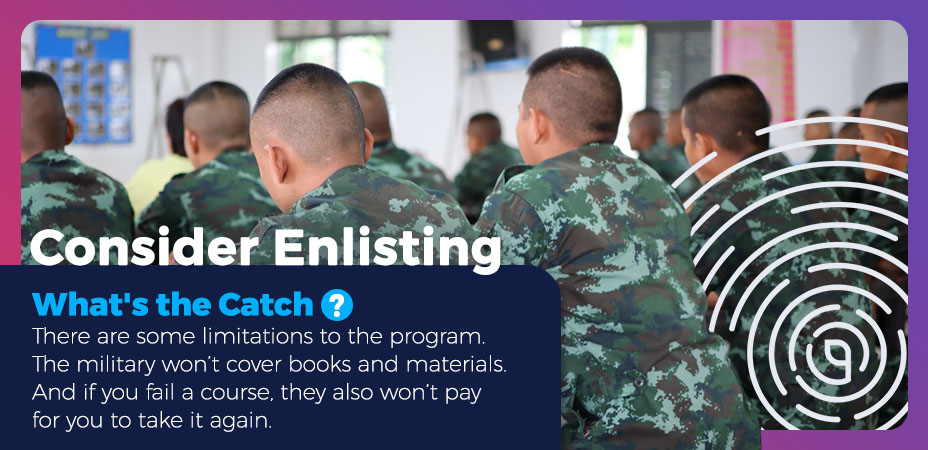Bigger paychecks. Better career opportunities. Ride or die friendships. There’s no doubt that college can be the start of many amazing things. But as we all know, it can also lead to a mind-boggling amount of student debt. American families spent an average of $30,017 on college costs for the 2019-20 academic year, according to a recent Sallie Mae survey.
Wouldn’t it be ah-mazing if you could go to college for free? The good news is you can! From participating in service opportunities to applying for college scholarships, there are several ways to lower the sticker price of higher education. The best part is that you don’t need to sign any student loans to bring the cost of tuition down to $0.
We know what you’re probably thinking: This seems a little sus. What’s the catch?
NGL, there is usually a small caveat with “free” college. After all, if it were that easy to get out of paying college tuition, everyone would just light their student loan agreements on fire and call it good.
That being said, you may find that graduating from college debt-free is well worth the potential trade-off involved. Interested to learn more? Read on to find out how to go to college for free.
1. Apply for Grants and Scholarships
HOLD IT. Don’t you dare scroll past this one because you assume that you aren’t qualified for financial aid. Even if your parents have a high income and your only special talent is being able to cook minute rice in 59 seconds, you can and should still apply for grants and scholarships.
Why? Because scholarships and grants are free sources of money that can be awarded for anything — and we literally do mean anything.
For instance, the Make Me Laugh Scholarship asks applicants to write a 250-word essay about an embarrassing or funny story. Like, you could tell them about that one time you thought the guy at the DMV said “count to five” instead of “counter five” and you embarrassingly counted out loud in front of everyone because you thought it was some kind of weird test…
But that was just an oddly specific example, obvi. Because what kind of weirdo would do that IRL, right? LOL. *shifts uncomfortably*
Anyway, the point is that you shouldn’t count yourself out for college scholarships and grants. Although it’s true that full-ride scholarships are hard to come by, many students end up winning a handful of smaller scholarships that help them shrink the cost of their degree.

What’s the Catch?
There’s not really a catch in this case. But keep in mind that applying for financial aid can be a lot of work. It requires staying on top of important deadlines and knowing when to apply for scholarships to maximize your chances of winning, all while juggling school work and other responsibilities.
BTW, don’t forget to fill out the Free Application for Federal Student Aid (FAFSA®) to see if you qualify for need-based aid. This typically becomes available at the beginning of October. And fill it out ASAP! The earlier you fill it out, the better your chances of scoring free money for college.

2. Attend a Tuition-Free College
Another way to avoid paying a single penny on college tuition is by attending a tuition-free college. Yes, you read that right. Tuition-free.
What kind of institution offers free tuition, you ask? The kind that is located in a state with a so-called promise program, which is a program that funds two or more years of education at participating community colleges and vocational schools.
Promise programs give students from all backgrounds an affordable pathway to an associate degree or two-year certificate. Students can choose to enter the job market immediately upon graduation or continue their education by transferring from community college to a university. And some state programs — perhaps most notably, New York’s Excelsior Scholarship — even cover all four years of college tuition!
What’s the Catch?
For one thing, tuition-free colleges are often highly competitive. Knowing what colleges look for in a successful student applicant is key to getting into a tuition-free school like Berea College or Barclay College.
And when it comes to applying for tuition-free colleges, be sure to read the fine print. In exchange for free tuition, you may be required to work on campus for a certain number of hours each week.
It’s also important to point out that tuition-free colleges don’t typically cover the cost of books or room and board. You may need to pick up one or two side hustles for college students to help pay for the remainder of your education.
3. Look for Career-Specific Grants
Thinking about pursuing a career in an in-demand field? Landing a career-specific grant can help you pay for your degree. Many organizations, businesses, governments, and colleges have established specialized grants that offer an incentive for students to pursue an education in high-need fields, such as nursing and teaching.
For instance, the Department of Health and Human Services offers a Nurse Corps Scholarship Program that provides awards for nursing students. In exchange, nursing students must work in a facility with a critical nursing shortage for a minimum of two years.
Keep in mind that “in-demand fields” can vary from state to state. For example, the Georgia Hope Grant offers free tuition for students who select majors aligned with industries that are currently facing a skilled worker shortage in Georgia, such as computer technology, health science, movie production/set design, and precision manufacturing.

What’s the Catch?
In exchange for funding their education, many career-specific grants (like the Nurse Corps Scholarship Program) require students to work for a certain number of years in a specific location after obtaining their degree.
NBD, right? Except for one thing: Your grant will turn into a loan if you suddenly decide you don’t want to fulfill your end of the bargain. Think carefully about your career choice and read the fine print before you accept a career-specific grant.

4. Ask Your Employer to Fund Your Education
Perhaps you found a job after high school and decided to put college on the backburner for a few years. But after watching your colleagues with degrees advance their careers, you’ve been thinking about going back to school. The only thing stopping you from making your dreams a reality is the insane cost of college tuition.
If you don’t want to pay for your college degree, consider asking your employer to pick up the tab. Yep, we’re being totally serious. While it might seem like a long shot, many employers recognize that funding your education is a win-win situation.
Paying employees to go back to school can boost loyalty, reduce turnover, and increase the number of skilled employees within an organization. An additional incentive? Companies that fund their employees’ education can take advantage of tax deductions.
What’s the Catch?
While large employers like UPS and Starbucks have well-established tuition reimbursement programs in place, smaller businesses are less likely to have them. In other words, be prepared to pitch the idea to your boss.
Before you ask your employer to pay for your education, be ready with some specifics. You should know what degree you want to get, which school you’d like to enroll in, and how your degree will benefit the company.
And if your employer considers the idea, don’t be surprised when they come back with a contract that requires you to work for them for a certain length of time. They don’t want to go through all the trouble of funding your education, only for you to bounce after you get your degree.
5. Get Your Tuition Waived
Another way you could potentially go to college for free is by qualifying for a tuition waiver, which would essentially cancel out the cost of college tuition. Many colleges and universities will grant tuition waivers to certain groups of people, which may include:
- Veterans and their immediate family members
- Students with Native American heritage
- Nontraditional students
- Employees of the school and their children
- Students who are enrolled in a STEM degree program
- Foster children
- High-achieving students
Students who experience some kind of financial or personal hardship can also be granted a tuition waiver. To apply for a hardship waiver, students typically need to complete the FAFSA and submit documentation that describes their situation.

What’s the Catch?
There is no catch. If the college grants you a tuition waiver, they’ll simply wave their magic wand and — POOF — your tuition fees are gone.
Of course, colleges don’t grant tuition waivers very often. You have to meet specific criteria, and even then, you may only get a partial tuition waiver. But still, it never hurts to ask! Get in touch with the school’s financial aid officer and ask about tuition waivers.
6. Go to College Overseas
College is crazy expensive in the United States. Elsewhere, though, it’s way more affordable. For example, countries such as Norway, Finland, Sweden, Germany, France, and Denmark provide free college or low-cost options to students who want to earn a degree.
And guess what? With the exception of a few student fees, two of those countries — Germany and Norway — extend their “free college” to international students. In other words, you could potentially satisfy your wanderlust and get a college degree for free at the same time.
That being said, students shouldn’t choose to pursue a degree abroad for the sole purpose of saving money. Higher education in Europe differs vastly from the United States. Do your research and consider your career goals before you make a decision one way or the other.

What’s the Catch?
Well, certain parts of Norway get cold AF. Just kidding (but not really). The real catch with this option includes all the hidden costs involved with studying abroad. Although tuition itself might be free, international students will still need to pay small fees every semester and may not have access to financial aid.
You’ll also want to think about the cost of living. Munich, for example, is Germany’s most expensive city. If you want to study in Toytown, it’s gonna cost you.
7. Consider Enlisting
If scholarships, grants, and tuition assistance programs won’t cover the cost of attending college, the military might pay for it. Sure, this option isn’t for everyone, but it may be worth considering if you were thinking about joining the military anyway.
Through the Armed Forces Tuition Assistance program, active-duty service members can pursue a degree, all on the military’s dime. The program may fund the entire cost of college tuition and certain fees, so long as the semester hours don’t exceed $250 per credit hour or $4,500 per fiscal year.
There are some limitations to the program. The military won’t cover books and materials. And if you fail a course, they also won’t pay for you to take it again.
Another option is the Reserve Officer Training Corps (ROTC), which is a program that provides a paid college education for high school students in exchange for a period of service with the Army. Students who receive an Army ROTC scholarship and go through the program must agree to serve for four years after graduation.

What’s the Catch?
The military offers great benefits at a great cost. As an active duty member, you could be deployed at any time. Be aware that, even in peacetime, things can change overnight.
While the ROTC program may be easy to join, the training is seriously no joke. ROTC students must endure a rigorous training program designed to prepare them for a future military career. And if you’re expelled from the program or decide to drop out, you will need to pay back your scholarship.
Going to College for Free
There you have it — how to go to college for free. Pursuing any of these options could help you earn a degree for free or at a deeply-discounted price. However, keep in mind that side-stepping the cost of tuition usually comes with a catch. Make sure that you understand what you’re getting into before you sign the dotted line!
Image Credits:
fongbeerredhot / Shutterstock
panitanphoto / Shutterstock
New Africa / Shutterstock
fizkes / Shutterstock
Iakov Filimonov / Shutterstock
wavebreakmedia / Shutterstock
Kite_rin / Shutterstock




